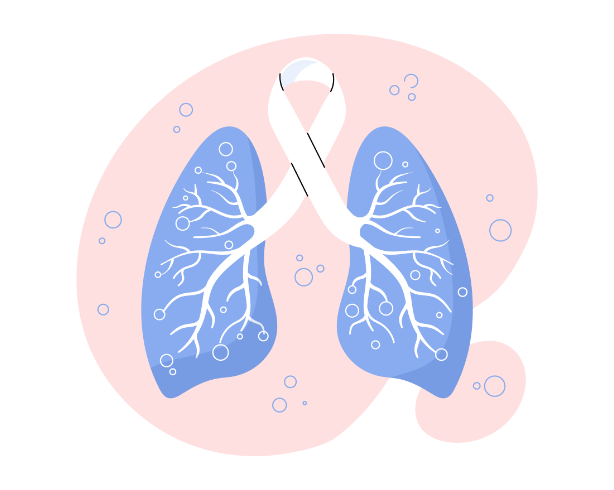Interstitial Lung Diseases
Interstitial lung diseases (ILDs) represent a broad category of lung conditions.
The interstitium is the lace-like network of tissue that extends throughout both lungs, supporting the alveoli and facilitating gas exchange. ILDs involve inflammation and/or scarring (fibrosis) of the lung interstitium, leading to progressive lung damage, and ultimately affecting breathing efficiency and oxygenation of the blood.
There are over 200 different types of ILD, each with its unique characteristics and causes.
Some of the common types include:
Understanding ILD and the different types allows for early detection and treatment of the disease, which can slow disease progression. Detecting ILD early also helps tailor treatment plans to individual patients, ultimately improving their quality of life.


Causes and Risk Factors
The specific causes of ILDs can vary widely depending on the type of disease. Common causes of ILDs include:
- Connective Tissue Disorders: Conditions such as rheumatoid arthritis, systemic sclerosis, and SLE can lead to ILD as a secondary complication.
- Drug-Induced ILD: Certain medications, including some antibiotics and chemotherapy drugs.
- Infections: Chronic infections, such as tuberculosis or certain fungal infections, can lead to ILD.
- Radiation Therapy: Individuals who have received radiation treatment for cancer may develop ILD as a late complication.
Symptoms of ILD
Symptoms of ILD can develop gradually and might be initially attributed to aging or lack of fitness.
Common symptoms of interstitial lung disease include:
- Shortness of breath, initially during exercise and eventually at rest
- Dry cough
- Fatigue
- Weight loss
- Chest discomfort
If you are experiencing any of the above symptoms, or if you have an existing connective tissue disorder or autoimmune disorder with worsening respiratory symptoms, schedule a consultation with the lung specialists at North Brisbane Sleep and Thoracic.


Diagnosis of ILD
Diagnosing ILD involves a combination of clinical evaluation, imaging tests, and sometimes lung function tests or lung biopsies. Key diagnostic tools include:
Identifying ILD early allows North Brisbane Sleep and Thoracic’s respiratory specialists to manage symptoms more effectively, which can help slow disease progression and improve the patient’s daily functioning and comfort.
Treatment Options
There is sadly no cure for mort types of ILDs. Lung disease treatment options for ILD are highly individualised, focusing on managing symptoms, slowing disease progression, and improving quality of life.
NBST offers a range of treatment and management options for ILD
Managing ILD
Managing interstitial lung disease requires a comprehensive and long-term approach to address the progressive nature of the condition, alleviate symptoms, and improve the patient's quality of life.
ILD Research and Advancements
Studies are exploring novel biomarkers for early diagnosis and disease monitoring, as well as new therapeutic targets. Advances in imaging techniques are improving the ability to detect and assess disease progression, while clinical trials are testing new medications and combination therapies that aim to reduce inflammation, slow fibrosis, and improve patient outcomes.
Research into targeted therapies and personalised medicine may offer more effective and tailored treatment options for different ILD subtypes. Innovations in drug development, including antifibrotic agents and immune-modulating drugs, hold potential for better management of the disease. As research continues, these developments are expected to significantly improve treatment options and patient quality of life.
Why Choose NBST?
North Brisbane Sleep and Thoracic stands out for its expertise in managing interstitial lung disease, leveraging a team of respiratory specialists with extensive experience in diagnosing and treating various forms of ILD. Their knowledge in the latest advancements and treatments ensures that patients receive the most effective care tailored to their specific needs.
NBST is dedicated to a comprehensive care approach that addresses every aspect of ILD management. This includes a combination of advanced diagnostic tools, personalised treatment plans, and ongoing support. Choosing NBST means benefiting from a thorough, patient-centred approach to managing ILD.
If you’re experiencing any symptoms of ILD, contact NBST for comprehensive support.

Contact us to book an appointment
Visit us at either our Clayfield or North Lakes location and experience compassionate care in a comfortable environment, tailored to meet your unique needs.

